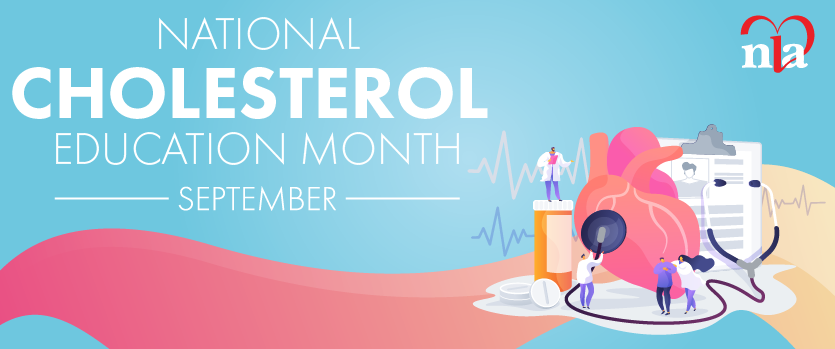From Everyday Health: 10 Things You Need to Know About Inherited High Cholesterol: An Interview with James Underberg, MD
If your bad cholesterol, LDL, is below 100 mg/dL and your good cholesterol, HDL, is above 40 mg/dL for men or 50 for women, your levels are healthy. But two out of every three adults have high cholesterol, according to the U.S. Centers for Disease Control. And high cholesterol puts you at risk for heart disease, the No.1 killer in the United States today.
For some people, high blood levels of cholesterol come from a diet that is high in fat and animal products, but for others, high cholesterol is genetic. In addition to getting cholesterol from dietary sources, our bodies make it too, and some bodies produce more cholesterol than can be safely handled, causing a buildup of fat in the arteries.
Everyday Health spoke with James Underberg, MD, from the NYU Center for Cardiovascular Disease Prevention, to help us understand an inherited high cholesterol condition that is common mutation in certain populations. Dr. Underberg is Director of the Bellevue Hospital Lipid Clinic in New York City, and the President of the Northeast Chapter of the National Lipid Association.
Everyday Health: How common is the inherited, high cholesterol condition called familial hypercholesterolemia, or FH, in the United States?
Dr. Underberg: A lot more common than people think; it affects 1 in 400 people in the general population. It is more common than other genetic diseases that get a lot more air time. In founder populations — French Canadian and Ashkenazi Jewish populations, for example — [FH occurs in] 1 in 100 people. This is a genetic condition that shortens lifespan and is treatable.
Everyday Health: Is the incidence of this genetic form of high cholesterol stable or on the rise in the U.S. population?
Dr. Underberg: The incidence is stable as a genetic condition. We are seeing a slow uptake in awareness now, so that both patients and practitioners are more aware.
EH: How many people do you think have the condition but have not yet been diagnosed?
Dr. Underberg: The diagnosis rate is between 1 percent and 20 percent. At a maximum, 20 percent are getting diagnosed in the United States. In the Netherlands and in the U.K., there is more awareness [of genetic high cholesterol].
EH: How is familial hypercholesterolemia diagnosed?
Dr. Underberg: For the majority of people, there are no symptoms until they have a heart attack. Patients may have bumps [deposits of cholesterol] around the eyes, bumps on the tendons, but many patients don’t. A white ring around the cornea of the eye is sometimes seen in patients, even under the age of 45 years. The main symptoms are high cholesterol levels and a family history of high cholesterol.
EH: Is it inherited by all the children in a family or only some of them?
Dr. Underberg: Assuming that a parent has FH, there is a one in two chance that a child will have it, a 50 percent likelihood.
EH: What is different about the genes in families with this inherited condition?
Dr. Underberg: There are several genes that are involved in how we dispose of cholesterol in the liver. The LDL receptor is a protein in the liver that gets cholesterol out of the bloodstream. In the majority of familial hypercholesterolemia cases, there is a mutation in the LDL-receptor gene. They can’t get rid of cholesterol, so the liver makes more cholesterol, because it doesn’t realize it has enough from the bloodstream. This makes it very difficult to get cholesterol levels down.
EH: What are the consequences of not treating very high cholesterol?
Dr. Underberg: Lifetime risk of a cardiovascular event — heart attack or stroke — is 20 times greater for someone with FH. And for women in the age group of 20 to 39, there is 125 times greater risk.
Men tend to have cardiovascular events 10 years earlier, in their thirties and forties, and women in their fifties and sixties.
EH: How is high cholesterol treated in patients with genetic high cholesterol?
Dr. Underberg: We encourage a heart healthy lifestyle: exercise, low fat diet, not smoking. But this condition starts at birth; cholesterol is high from day one [in patients with FH]. Diet alone is rarely enough. Statin medication is the cornerstone of treatment for these patients, but it is often not enough.
Other medications, like ezetimibe [Zetia, which decreases cholesterol absorption in the intestine] and bile acid sequestrants [such as cholestyramine or colestipol] can also be used. Some patients can’t tolerate medications, or their cholesterol is so high that medications don’t work. [For them] LDL apheresis is a procedure to remove cholesterol from the blood, like dialysis, done every one to two weeks.
New medications were recently approved by the FDA for extraordinary cases — Kynamro and Juxtapid — but these have side effects.
EH: Is premature heart disease preventable in people with familial hypercholesterolemia?
Dr. Underberg: There are no prospective trials for ethical reasons; data we have is observational. For FH patients on statins, the risk level is similar to that in people without FH. This fits with the cholesterol hypothesis, that patients born with low cholesterol don’t get heart disease.
EH: What do you do to raise awareness about FH in your community?
Dr. Underberg: This is something I’m really passionate about. I am the president of the Northeast Chapter of the National Lipid Association. Because September is Cholesterol Awareness Month, we’re going to work at a health fair on September 7 in New York City to promote awareness about FH locally. Nationally, the Foundation of the National Lipid Association offers public service awareness at www.learnyourlipids.com. Another source of information is the FH Foundation.
Because people with this condition are at higher risk, we try to make sure that people are identified so their kids can get screened. A child is potentially at risk, but no one may have told them to get screened. By ages 9 to 11, all children should get screened for cholesterol levels. Then if they have FH, they can institute diet and exercise early on as lifestyle changes.






.jpg)
.png)










